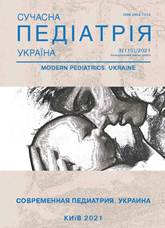Long-term consequences of Lyell's syndrome suffered in childhood
DOI:
https://doi.org/10.15574/SP.2021.115.69Keywords:
Lyell's syndrome, children, Long-term consequences, chronic obstructive bronchitis, obesity, treatmentAbstract
The article provides a review of literature on the long-term consequences of Lyell's syndrome (one of the forms of toxic epidermal necrolysis). Among them: chronic eczema with xerosis and itching, skin depigmentation, hypertrophic and keloid scars, nail lesions, eyes, including dry eye syndrome and chronic conjunctivitis with/without obliteration of the nasolacrimal canal, kidney disease, lung disease, Sjogren's syndrome, Hashimoto's thyroiditis and others.
Clinical case. The authors present their clinical case of an 11-year-old girl who suffered from Lyell's syndrome at the age of 8 and has been observed for the past three years, share their clinical and laboratory-instrumental observations and treatment strategies. In particular, they report about the revision of the clinical diagnosis with which the girl was admitted to the OHMADYT hospital, from BA to chronic secondary obstructive bronchitis, the detection of chronic conjunctivitis with obliteration of the nasolacrimal canals, chronic sinusitis, secondary immune deficiency, keloid skin scars.
Conclusions. Despite constant rehabilitation therapy and a significant improvement in the general condition of the girl, it was not possible to fully restore the function of mucociliary transport, as a result ventilation of small bronchi gradually deteriorates, bronchiectasis is observed in the basal segments of the right lung, a polyserial strain S. aureus is formed, which is constantly sown from the child's sputum; it was not possible to fully restore the patency of the nasolacrimal canals and achieve a stable remission of chronic sinusitis.
The research was carried out in accordance with the principles of the Helsinki Declaration. The informed consent of the patient was obtained for conducting the studies.
No conflict of interest was declared by the authors.
References
Andreeva IV, Stetsyuk OYu. (2013). Allergicheskaya reatsiya na antibiotiki. Klinicheskaya farmakologiya. 2: 5-10.
Bayaki Saka, Abla Sefako Akakpo, Julienne Noude Teclessou, Garba Mahamadou, Abas Mouhari-Toure et al. (2019). Ocular and Mucocutaneous Sequelae among Survivors of Stevens-Johnson Syndrome and Toxic Epidermal Necrolysis in Togo Dermatology Research and Practice. 2: 1-6. https://doi.org/10.1155/2019/4917024; PMid:30838038 PMCid:PMC6374872
Che-Wen YANG, Yung-Tsu CHO, Kai-Lung CHEN1 et al. (2016). Long-term Sequelae of Stevens-Johnson Syndrome/Toxic Epidermal Necrolysis. Acta Derm Venereol. 96: 525-529. https://doi.org/10.2340/00015555-2295; PMid:26582440
Dweik RA, Boggs PB, Erzurum SC et al. (2011). An official ATS clinical practice guideline: interpretation of exhaled nitric oxide levels (FENO) for clinical applications. Am J Respir Crit Care Med. 184 (5): 602-615. https://doi.org/10.1164/rccm.9120-11ST; PMid:21885636 PMCid:PMC4408724
Fakoya J, Omenyi P, Anthony P et al. (2018, Apr 15). Stevens-Johnson Syndrome and Toxic Epidermal Necrolysis; Extensive Review of Reports of Drug-Induced Etiologies. Open Access Maced J Med Sci. 6 (4): 730-738. https://doi.org/10.3889/oamjms.2018.148; PMid:29731949 PMCid:PMC5927512
Ingen-Housz-Oro S, Alves A, Colin A, Ouedraogo R et al. (2020, Apr). Health-related quality of life and long-term sequelae in survivors of epidermal necrolysis: an observational study of 57 patients. BJD. 182 (4): 916-926. https://doi.org/10.1111/bjd.18387; PMid:31385287
Kamada N, Kinoshita K, Togawa Y, Kobayashi T et al. (2006, Sep). Сomplications associated with toxic epidermal necrolysis: report of a severe case with anti-Ro/SS-A and a review of the published work. J Dermatol. 33 (9): 616-622. https://doi.org/10.1111/j.1346-8138.2006.00142.x; PMid:16958806
Mezhirova NM, Bevz SI, Adaryukova LM, Glavatskih DM, Danilova VV, Kritsyina TN. (2011). Osobennosti techeniya i lecheniya sindroma Layella. Meditsina neotlozhnyih sostoyaniy. 5: 36.
Sheridan R, Ryan C, Schulz J. (2002). Long-Term Consequences of Toxic Epidermal Necrolysis in Children. PEDIATRICS. 109 (1): 74-78. https://doi.org/10.1542/peds.109.1.74; PMid:11773544
Sun Hye Hwang, Dong Hyun Kim, Jeong Hee Kim, Byong Kwan Son, Dae Hyun Lim. (2013, Dec). Chronic pulmonary complications due to toxic epidermal necrolysis. Allergy Asthma Respir Dis. 1 (4): 391-394. https://doi.org/10.4168/aard.2013.1.4.391
Viktorov OP, Koliadenko VH, Matvieiev OV. (2007). Urhentni proiavy pobichnykh reaktsii z boku shkiry pry medychnomu zastosuvanni likarskykh zasobiv. Syndrom Laiiella Ratsionalna farmakoterapiia. 1: 2.
Downloads
Published
Issue
Section
License
Copyright (c) 2021 Modern Pediatrics. Ukraine

This work is licensed under a Creative Commons Attribution-NonCommercial 4.0 International License.
The policy of the Journal “MODERN PEDIATRICS. UKRAINE” is compatible with the vast majority of funders' of open access and self-archiving policies. The journal provides immediate open access route being convinced that everyone – not only scientists - can benefit from research results, and publishes articles exclusively under open access distribution, with a Creative Commons Attribution-Noncommercial 4.0 international license (СС BY-NC).
Authors transfer the copyright to the Journal “MODERN PEDIATRICS. UKRAINE” when the manuscript is accepted for publication. Authors declare that this manuscript has not been published nor is under simultaneous consideration for publication elsewhere. After publication, the articles become freely available on-line to the public.
Readers have the right to use, distribute, and reproduce articles in any medium, provided the articles and the journal are properly cited.
The use of published materials for commercial purposes is strongly prohibited.

